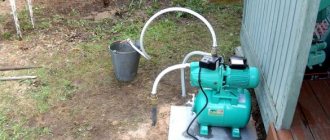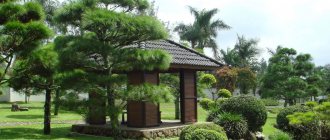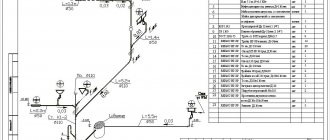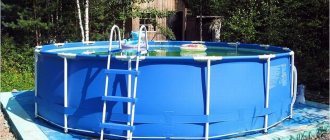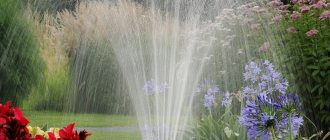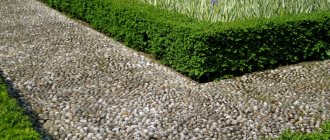The importance of a full-fledged water supply in the countryside cannot be overestimated. Without a constant water supply, caring for the area becomes extremely labor-intensive, and ordinary washing of dishes turns into a real ordeal, not to mention the use of modern household appliances that require connection to water supply and sewerage.
Do-it-yourself plumbing in the country
That is why almost every owner of a summer cottage wants to equip a full-fledged water supply system. It is quite possible to cope with the solution of this problem with your own hands. This is, firstly, an invaluable experience, and secondly, an excellent opportunity to save money by refusing the services of third-party craftsmen.
General plan of how to make a country water supply system
Features of a private water supply system
It is better if the planning of the water supply is carried out at the stage of drawing up the design of the summer cottage and house. A full-fledged project includes a number of drawings and documents, including:
- step-by-step work plan;
- layout diagrams of pipes and main elements of the water supply system;
- estimate, etc.
Plumbing diagram
To install a boiler and water meter unit, you need to allocate a small room on the first floor of the house. A room of 3-4 m2 will be sufficient. It is more convenient when the water input unit and the necessary technical devices are located in the same room - this gives the owner the opportunity to fully control the water supply process.
A typical private water supply system includes the following equipment:
- pipeline. Products made of polypropylene, metal-plastic and metal are suitable;
- set of taps and fittings;
Pipes and fittings - pump;
Surface pump for lifting water from a well - pressure gauge; Pressure gauge DM02 Meter
- expansion tank;
Expansion tank - pressure switch; Pressure switch RD-2R (Rosma)
- electrical support with full automatic protection;
- purification filters for removing suspended particles and various types of contaminants from the water;
Water purification filter - water heater. Installed as needed. In most cases, the cumulative model is more convenient.
Practical storage water heater for a summer residence
Required Tools
To carry out work on arranging the water supply of a private home, you will need the following list of tools:
- shovel;
- adjustable and gas wrenches;
- welding machine for polypropylene pipes;
- roulette;
- pipe cutter;
- knife;
- hacksaw saw;
- silicone and sealant and a gun for them.
For electrical work you will need:
- screwdriver;
- tester;
- wire cutters and other electrician tools.
Since drilling a well yourself is highly not recommended, tools for performing this work are also not indicated on this list.
Selecting a water supply source
In the process of designing a country water supply system, you need to choose the optimal source of water. Check out the available options and choose the one that best suits your case.
Centralized water supply
Centralized water supply
The simplest and most convenient option. It is important that the pressure in the system is sufficient to deliver water to the building. Otherwise, you will need to additionally buy a pump or consider other methods of water supply.
Water will be supplied to the building through a system of pipes and fittings.
In this case, to install a water supply system, you usually do not need to buy any additional devices - you simply need to dig a trench, lay down the water supply elements and cut into the central main line.
Centralized water supply at the dacha
If you are unable to connect to a central line, consider the following options.
Mine well
Mine well
The method is suitable for areas with an underground aquifer depth of at least 8-10 m.
The well shaft is equipped with the efforts of 2-3 people - doing it alone is too long and difficult.
Digging a well
The main advantage of the option under consideration is the extreme simplicity of the system - you can maintain and repair it on your own. Maintaining such a well in good condition does not require significant costs.
The main disadvantage is the strictly limited water supply. Not every individual well can provide as much water as is necessary to satisfy all the needs of the family.
Water supply device from a well
This is what a well looks like with a pipe connected and a submersible pump running
Before choosing this option, calculate the amount of water you need and determine how much water the well can produce.
The installation of a water supply system based on a shaft well requires the use of a surface pump. The equipment is relatively inexpensive and easy to maintain.
Surface pump for country water supply from a well
Surface pump connection
Prices for a linear series of pumping stations
Pumping stations
Well
If the underground aquifer lies deeper than 8-10 m, you will have to drill a well. The pleasure is not cheap - drillers charge quite a significant amount of money for their work.
Water supply diagram from a well
But, having spent money once on installing a well, you will provide your dacha with clean water in the required volumes. If you want to save money, you can try to negotiate with your neighbors and make one well for several houses.
How to install water supply from a well
To install a water supply system in this case, you will need a special borehole or submersible pump. Such equipment is much more expensive than its surface counterparts, but in terms of efficiency in providing clean water, it has no equal.
The nuances of installing water supply from a well
Eventually
The final stage of arranging a water supply system is its inspection. To do this, the pump is turned on and water enters the system under pressure. In this way, the quality of the connection of all connecting points is checked in case of water leakage.
A country water supply system can be used not only to supply water, but also to operate sewerage systems and install fire hydrants.
Having installed a water supply system at the dacha, it becomes possible to use a sink in the kitchen, a toilet, a shower, a washing machine - the whole set of civilized life that is familiar in the city, without which the life of a modern person in a dacha seems limited.
Summer and winter water pipes
Previously, you most likely heard such definitions as summer and winter water supply systems. Study the basic properties of these options; it is quite possible that even the simplest summer option will be able to satisfy your needs. Otherwise, you can immediately proceed to study the following sections of the manual, devoted to the arrangement of a full-fledged water supply system.
Summer option
Summer water supply in the country
The features of such a water supply system are clear from its name - the operation of such a system is possible only during the warm period. There are stationary and collapsible modifications of the system.
The collapsible summer water supply system has a very simple design: it is enough to connect the hoses to a pump with suitable parameters and lay them along the surface of the soil so that they do not interfere with normal movement around the summer cottage.
Summer water supply at the dacha
Silicone and rubber hoses are suitable for arranging the system. The connection is made using special adapters. Also available in specialized stores are more modern products for connecting hoses - latches. One side of such a latch is equipped with a spring-loaded connector, and the other has a “ruff”. With the help of such latches, hoses are connected quickly, securely and simply.
Most often, such a collapsible system is used for irrigation. It makes no sense to organize a full-fledged water supply on its basis to solve domestic needs.
Piping for summer water supply
Laying of a stationary summer water supply system is carried out underground. Flexible hoses are not suitable for arranging such a system. The best option is plastic pipes.
Pipes of a stationary seasonal water supply are laid at a meter depth. After the end of the season, water must be pumped out of the pipes, otherwise, with the arrival of cold weather, it will freeze and ruin the pipeline.
In view of this, the pipes must be laid with a slope in the direction of the drain valve. The valve itself is installed near the water source.
Winter option
This type of water supply can be used throughout the year.
Plumbing in the country
Pipes made of polyethylene and polypropylene are suitable for arranging the system. The former are sold at a lower price and are installed without the use of special tools. The latter are somewhat more expensive and require the use of a soldering iron for pipes during installation. However, in the end, you will spend more money on additional parts for installing polyethylene-based pipes than on additional products used when installing polypropylene pipes.
Are you doing plumbing?
We recommend that you familiarize yourself with the step-by-step technology for installing sewerage in your country house - link to the article.
And also read about drilling a well with your own hands.
And don’t forget to look at the article about how to choose a pump for a well, link here.
Water pipes are laid with a slight slope towards the water supply source. The pipeline should pass 200-250 mm below the freezing point of the soil.
Pipe slope
There is also an option with pipe laying at a depth of 300 mm. In this case, additional insulation of the pipeline is required. Foamed polyethylene performs excellent thermal insulation functions. There are special cylindrical products. It is enough to simply put such rounded polypropylene on the pipe and as a result the product will be reliably protected from cold and other adverse influences.
Not only the winter water supply pipes, but also the water source need additional insulation.
Polystyrene “shell” for pipe insulation
For example, a well is insulated for the winter and covered with snow. These measures will be sufficient to protect the structure from the cold.
Well insulation
Surface pumping equipment, if used, is equipped with a caisson. A caisson is a pit with additional insulation, located next to a water supply source equipped with a pump.
Caisson
Installation of automatic pumping stations can only be carried out in a room where the air temperature does not drop to negative levels even in the most severe frosts.
Typical pumping station design
The sewer system also needs insulation. If it is absent, the drains will freeze and disrupt the operation of the drainage system.
Insulation of sewer pipes
Next, we will consider the procedure for arranging a full-fledged water supply system, which can be used at any time of the year.
Piping, boiler and expansion tank
Prices for water pipes
Water pipes
Selecting pipes
Here you need to correctly calculate the required amount. Take note of the slope and number of turns.
Having correctly identified them, you can take them in the required manufacture; they differ in the angle of rotation and this will greatly facilitate the work:
- The diameter of any pipes made of different materials (steel, polypropylene, metal-plastic) must be from 32 mm.
Attention: All connecting seams must be reliable and sealed, otherwise there will be a risk of pipe failure when the water pressure increases when using the water supply. Pay special attention to this.
- When choosing pipes, you should pay attention that the material they are made of is food grade and not technical. Be sure to check this out;
- We need to supply pipes to the premises; the trenches from the well to the foundation of the building must be at least a meter deep. It is important that the level of laying pipes in the trench is below the freezing point of the soil in your area. It is necessary to provide reliable protection by covering the pipeline with insulation (see How to insulate a well correctly). For this, mineral wool is used. It’s even better if you also lay a special electric cable for heating, which will provide heating and prevent the pipe from freezing;
- An above-ground option for laying pipes is also available. In this case, measures to insulate the external water supply must be carried out. The pipes are laid directly on the ground, or in a preliminary recess. At the same time, a heating electric cable is laid, but in this version it must already be present.
Drafting
Start by drawing up a system design. First of all, decide on the equipment. Specify the location of water intake points, calculate the required number of fittings, select the optimal material and type of water pipes.
Plastic pipes are used most often. These are durable and reliable products that fully cope with all the tasks assigned to them. At the same time, plastic pipes do not rust, which allows them to be sewn into walls, unlike their metal counterparts.
Draw up a detailed diagram of the future water supply system. Indicate all dimensions on the drawing. This way you can calculate the optimal footage and determine the required number of components. In this case, it is recommended to buy components with a 10-15 percent reserve.
You must also decide whether you will choose and buy all the necessary equipment yourself, or whether you will immediately buy a ready-made water intake station. At this point, be guided by your personal preferences.
Useful tips
When operating a country water supply scheme, the following recommendations will be useful to you:
- For heating the water supply in winter, a self-regulating heating cable is better suited. It is more expensive than resistive, but more economical to operate and easier to install.
- Before burying communications, mark their exact location on the site plan. Take photos of components and pipes hidden in the ground or behind trim. Print and save. It will be useful in the future in case of repair or reconstruction.
- Plastic should not be heated with an open flame from a blowtorch. In case the pipeline freezes, use a hair dryer. In addition to warming up communications, the device is also useful for other household needs.
- To automatically shut off the water supply to the reserve tank, it is not necessary to buy expensive float valves. Suitable for a simple toilet cistern. It is inexpensive and lasts for five years or longer.
In conclusion, an interesting video; from it you can also learn a lot of interesting things about the water supply system of a dacha.
Installation of plumbing system components
First step
Dig a trench from the water source to the point where the pipe enters the building.
Second step
Install the pump. Deep-type equipment is lowered into a water supply source. Surface pumps are mounted next to a well or well. The pump is installed in a heated room or in a caisson.
Pumping station
Third step
Connect the water pipe to the installed pump. Attach the free end of the connected pipe to a fitting with five terminals.
Fourth step
Installation of a water supply system
Connect a storage tank, a pressure gauge, and a pressure switch to the free outlets of the fitting. The volume of the storage tank can reach 400-500 liters or even more. Thanks to this device, optimal pressure in the water supply system will be ensured. In addition, you can store water in the storage tank in case of unforeseen situations.
Fifth step
Connect a pipe to the remaining free fitting outlet, and then run the line along the pre-leveled bottom of the dug trench straight into the house. You also need to lay a protected cable along the bottom of the pit to connect the pump and accumulator.
It is important that the outlet intended to power the above-mentioned units is properly grounded.
Sixth step
Installation of a water supply system in a dacha
Before the point where the pipe enters the building, install a shut-off valve. It will allow you to shut off the water supply if the need arises.
Seventh step
After making sure that the external pipeline is working correctly, fill the hole and begin installing the internal wiring.
Regardless of the chosen source of water supply, it is strongly recommended that the water supply system be equipped with cleaning devices
Perform internal wiring in accordance with the previously prepared diagram. At this point, be guided by your preferences. Do everything so that in the future it will be convenient for you to use the connected water supply.
Installation of internal water supply at the dacha
Finally, all you have to do is arrange water intake points by connecting faucets, appliances, etc.
Necessary equipment
To install a water pressure system at your dacha you will need:
- submersible well pump - its type and power depends on the depth of the well, the required volume of water and the nature of the system;
- HDPE pipes - usually 32 mm. Less commonly, a 40 mm pipe is required if the output is 1 ¼”;
- borehole head;
- fittings for joining pipes;
- cable with a moisture-proof sheath - for connecting the pump;
- heat-shrink sleeve for connecting the cable to the pump;
- stainless steel cable clamps;
- hot air gun or gas burner;
- filters - depending on the type of well and installation location;
- storage tank, if needed.
If other pipes are used - PVC, PPR - other connecting elements and special tools for soldering will be required.
Most pumps only work with clean water.
Providing hot water supply
If you need to provide hot water supply, you can supplement your plumbing system with a water heater. There are storage and flow-through varieties of such equipment. At dachas, it is most convenient to use storage tanks.
The installation of the water heater is carried out according to the standard scheme for such equipment.
How to connect a water heater
Now you know in what order the installation of the plumbing system is carried out and what needs to be taken into account for the successful implementation of all related activities. Do everything in accordance with the provisions of this guide, and your plumbing will serve well for many years.
Good luck!
Prices for the range of water heaters
Water heaters
Well
A modern, completely safe and convenient source of water for your site. The well is drilled to reach artesian waters, which is why it is also called artesian. The depth of the well can reach a depth of 200 m, but in most cases it is enough to drill to 30-50 m.
It must be remembered that if the depth is insufficient, there may be seasonal interruptions, as well as a decrease in quality during floods and rains.
The main advantages of the well should be considered the following points:
- You can drill on any site, in any place convenient for you;
- The water is environmentally friendly and completely safe for health;
- There is no need to use special filters. This simplifies the system and saves money;
- Durability of the source;
- Quality depends little on seasonal and weather conditions;
- Possibility of year-round use.
However, for all its advantages, the well has a number of disadvantages:
- Impossibility of independent drilling. You will definitely need to contact specialized organizations;
- High price of drilling operations;
- The need to prepare special documents for drilling a well;
- Difficult to maintain.
Nevertheless, the well is justifiably popular among summer residents, since it is a convenient, renewable and clean source of tasty, high-quality water.
Water heating
Water is heated using electric heaters and gas boilers. The latter are cheaper to operate, but require gas, documentation and professional installation. Electric models are simpler and more compact. You can easily install them yourself. According to the principle of operation, heaters are either flow-through or storage. The type of unit and its performance are selected based on the volume of water consumption.
For permanent residence, you can consider installing a double-circuit gas boiler, which provides both home heating and hot water supply.
Storage tank
Pressure in the water supply system is provided using a water tank. Its role is usually played by a large barrel located on a hill. It can be located in the attic or, if there is an attic instead, in a special insulated room. You can insulate the room using mineral wool or polystyrene foam. It is important to ensure that the tank is sealed. Otherwise, dust, debris and particles of insulation will get inside and pollute the water.
There are times when the water supply system needs to be preserved, for example, during departure. In this case, you need to get rid of all the water in the system. To do this, install a special drain valve.

